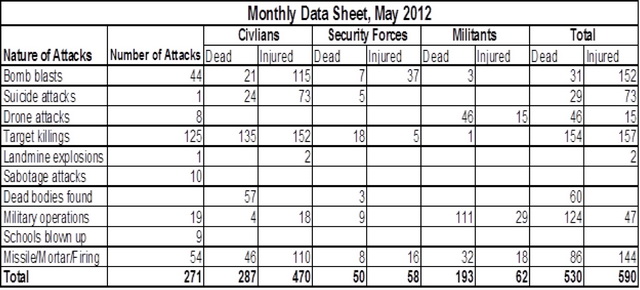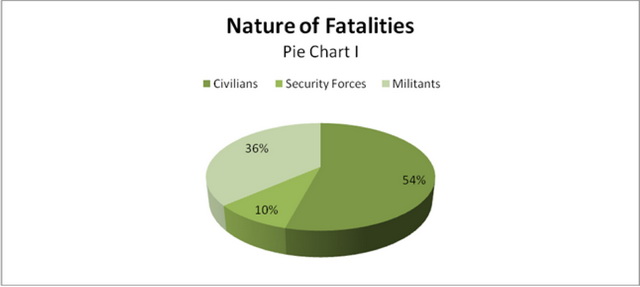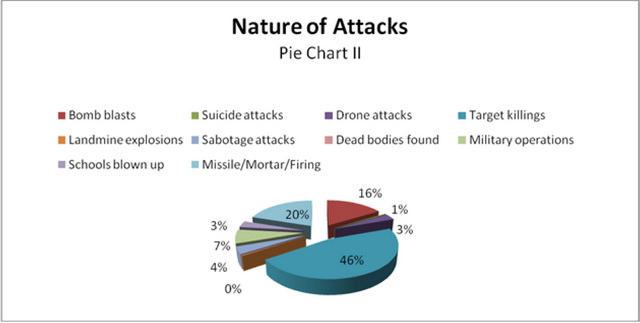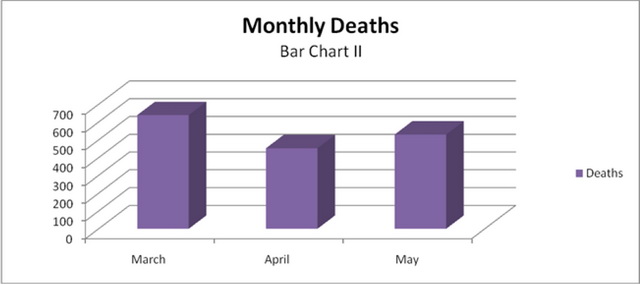All kinds of violence continued unabated during the month of May. Ethno-political violence in Karachi and religio-terrorism violence in Federally Administered Tribal Areas (FATA) and Khyber Pakhtunkhwa (KP) amounted for almost two third of the total deaths during May. The spree of target killing in Karachi has claimed 240 lives since March. Meanwhile, religio-terrorism violence in FATA and KP ate up almost 300 persons during the month under review. The data collected through different sources suggest that some 530 people lost their lives in 271 incidents of violence across the country (for details see data sheet). The overall level of violence escalated in comparison to April, wherein 453 people were perished. The violent clashes also left 590 people injured across the country during the reporting month.

A peer into the nature of fatalities suggests that civilians remain the most vulnerable segment of the society, with the civilians accounting for most of the deaths in various acts of violence and terror across Pakistan. As noted in pie chart I below, civilians accounted for almost 54 percent of the total dead in May. The proportion of the civilian deaths is slightly lower than the previous month, when 59 percent of the dead were innocent civilians. As a whole 287 civilians were killed in different circumstances during the month. The second highest number of fatalities is of militants– i.e. 36 percent of the total dead, 10 percent deaths were of the security forces and these were mostly recorded in insurgency infested areas of KP and FATA. Furthermore during May, eight CIA operated drone strikes were reported in North Waziristan Agency (FATA), leaving as many as 46 killed, most of them reportedly suspected militants. On the contrary during last month, only one drone attack was reported. It was very unusual lull in violence perpetrated by the US in tribal region. In total 23 drone attacks have left 132 suspected militants dead so far during the current year. Meanwhile, carrying on their sabotage campaign against state infrastructure, militants blew up nine government schools in different parts of FATA and KP during the course of month. Also, 10 sabotage attacks were reported in parts of Balochistan and Karachi, where miscreants blew up gas pipelines and power pylons.

Target-killings continued to top the modes of violence. As pie chart II below, depicts that staggering 46 percent of the total dead were the direct consequence of target killing, and 154 persons were shot dead across Pakistan in 125 incidents. Karachi witnessed the major loss of lives as a result of target killings, where 108 persons were shot-dead during the month under review. Meanwhile, military vs. militants– clashes were the second major cause of deaths; 124 people were killed, including 111 militants and nine security forces personnel. In May, 60 dead bodies were also recovered in different parts of Pakistan, most of them though found in Karachi, FATA and Balochistan. The third major cause of the violence was mortar attacks and firing. In total, 86 persons including 46 civilians and 32 militants perished in such attacks. Likewise, one suicide attack left 24 civilians and five security forces– men dead in FATA, the hotbed of war on militancy.

Looking at the scale of violence in different areas of the country it becomes clear that the month of May was not much different from April i.e. FATA and Karachi (Sindh) continued to top as areas seething under the violence. As bar chart I below underlines that almost 431 people were killed in the said areas under different circumstances. And it accounted for 78 percent of the total killings across the country during April. Like the previous two months, violence continued to dwindle in militancy stricken KP province, as during May 32 people were reportedly killed as a result of different violent incidents.

Furthermore, the sporadic violence out of sectarian motives intransigently continues to haunt Pakistan. Shia Hazara community based in Quetta (Balochistan) and Shia community in Karachi were the prime targets of the sectarian violence during the month. In case of Balochistan, 8 Shia persons were gunned down, allegedly by the majority Sunni extremist organizations, and most importantly, Lashkar-e-Jhangvi (LeJ). Meanwhile, 9 Shia people were shot dead in Karachi. In total, 20 people were killed as a result of sectarian violence across Pakistan during May.

During last three months (March-May), 1622 persons have been killed across Pakistan. March was the most violent month out of these three months, whereby large number of deaths were reported due to military-militants– clashes in FATA and KP regions. While violence drastically declined during April, when there was relative respite in war on militancy in FATA. But during May, violence picked up again in the said areas. The emerging violent trends during the last three months suggest that violence is gripping FATA, KP, Balochistan and Karachi evenly. It is an alarming trend at the same time, since it equates Karachi with FATA in insecurity milieu. Also, the trend justifies the repeated warnings by Karachi based political party and capture of high-value terrorist targets in the city that militants from tribal region of Pakistan are relocating to Karachi to avoid US drone attacks and Pakistani military. Although, on the face of it, the violence in Karachi is resulting from the struggle for control and power in the largest metropolis of Pakistan between two ethno-political parties, but at the core it looks as if hard core militants are also part of this unfolding quest for power and influence.
Sources
- The News
- Dawn
- The Express Tribune
- Pakistan Today
- Daily Times
- The Frontier Post
- Jang (Urdu)
- Daily Mashriq (Urdu)
- Aaj (Urdu)
- Balochistan Times
